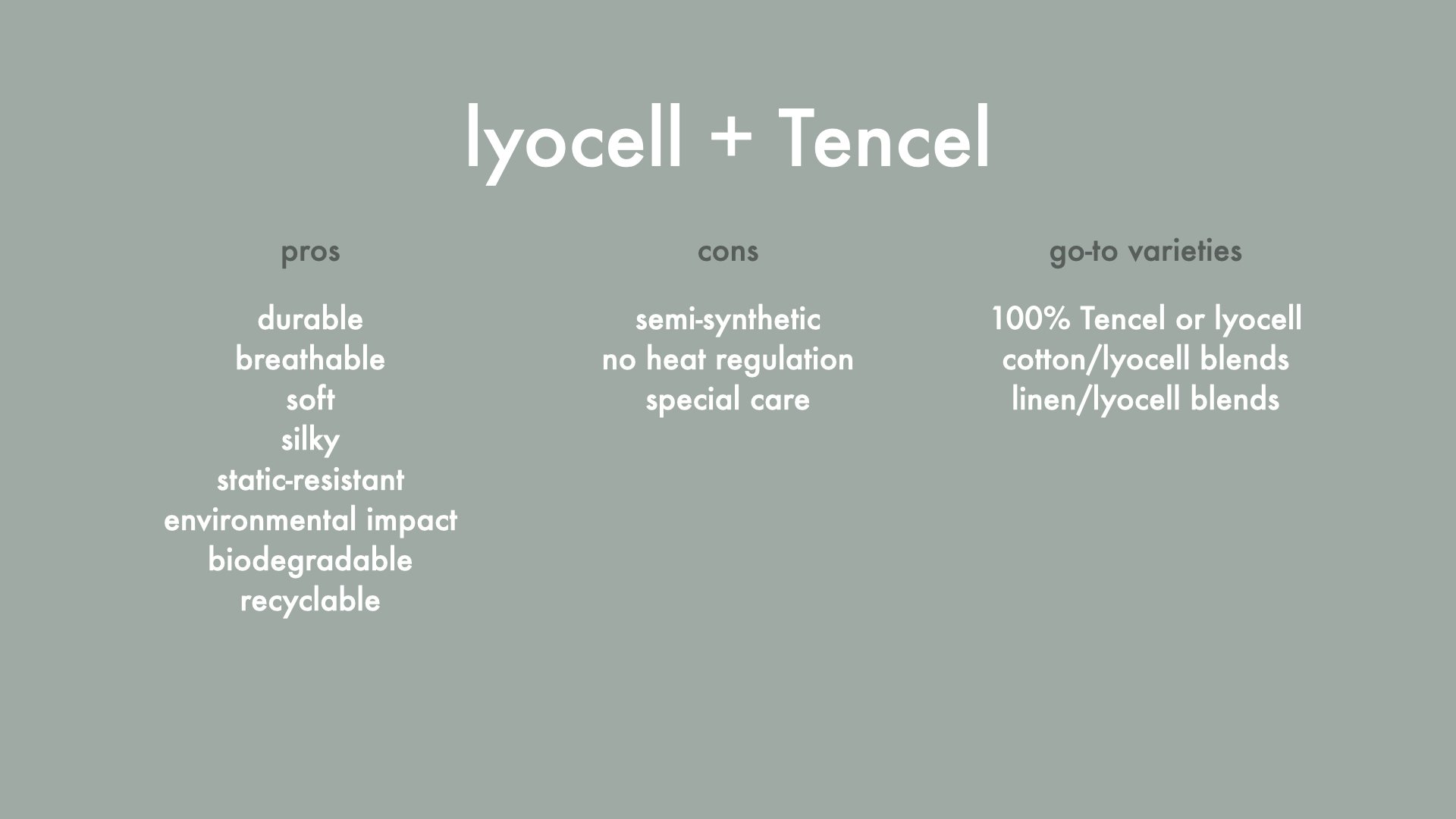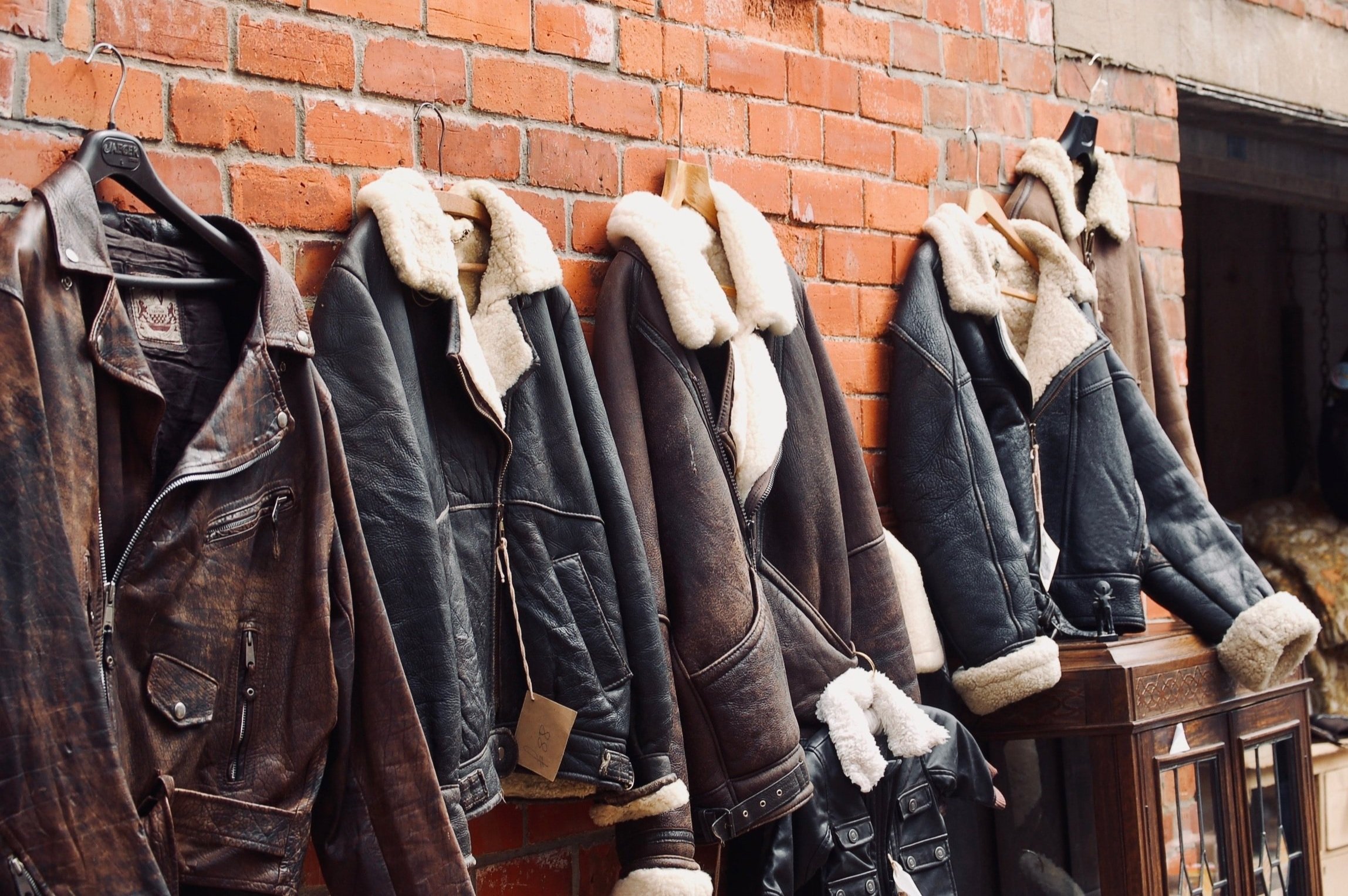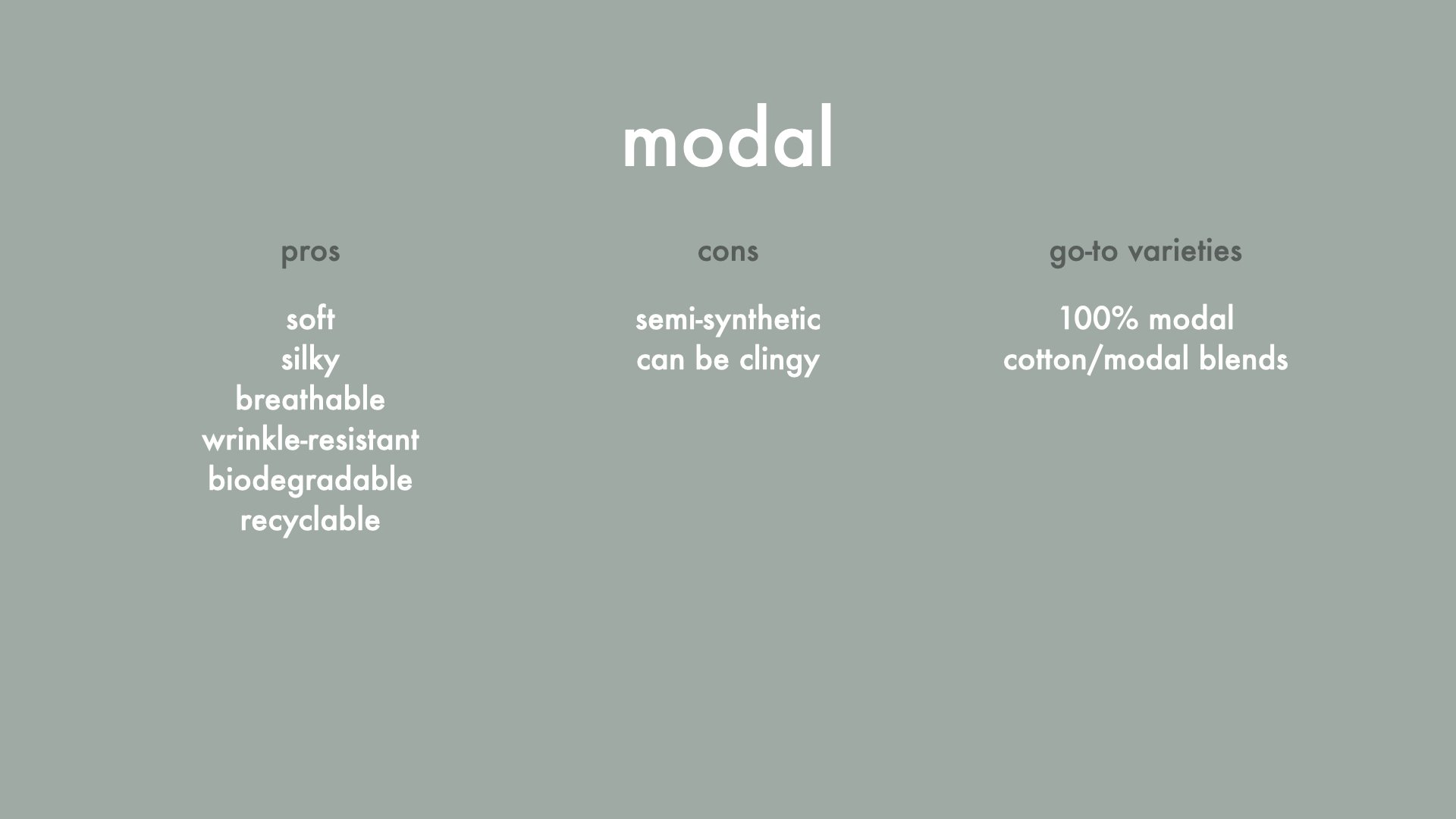Quality Clothing Guide: Materials
Our clothing can consist of so many different types of materials, both natural and synthetic. Cotton, spandex, wool, nylon, cashmere, neoprene, linen, acrylic, silk… But which fabrics are truly best for your wardrobe? In a nutshell, natural fibers almost always win out. In this post I am breaking down all of the best fabrics, what’s great about them, and some shopping tips along the way.
Natural fibers vs Synthetics
Before we get into the nitty gritty, let’s talk natural fibers vs. synthetics. Synthetic materials like polyester, acrylic, nylon, and materials which are blended with synthetics are not breathable and do not wick moisture away from the body. Synthetics and semi-synthetics are also produced with larger amounts of harmful chemicals than natural fabrics. Natural fibers are often superior to synthetics in quality, durability, and temperature-regulating properties. However, the main benefit of some synthetics and semi-synthetics is the improvement in fit. Synthetics can help to improve the stretch and drape of a fabric, resulting in a better fit on a curvy silhouette.
01 // Cotton
01 // COTTON
Cotton is the most common natural fabric in clothing today. It is breathable, and can be woven into a variety of textures and thicknesses. Cotton can be soft or stiff, making it a wearable fabric for all body types. Stiffer styles, like 100% cotton denim, chinos, or a crisp white shirt are more suited to angular body types. Softer styles flatter a curvy figure. Cotton gauze drapes nicely along curves, while a 95-98% cotton denim with 2-5% elastane or spandex will hug your shape while remaining comfortable and durable. Cotton/silk blends can also be great if you are looking for a softer draping cotton garment.
Although cotton is often used for sweaters and knits, it will not keep you warm in cold weather for extended periods of time. Cotton is very breathable and does not retain heat efficiently, even when thickly woven. Therefore, cotton is much better suited for summer clothing or light layers in the cooler months.
There are many different varieties of cotton to choose from. The best choices are pima cotton, organic cotton, and recycled cotton. Unfortunately, the production of cotton can be very harmful to the environment. According to the World Wildlife Fund, over 5,000 gallons of water are used to grow enough cotton to make just one t-shirt and a pair of jeans. Cotton crops also require a lot of pesticides. Opting for organic cotton or recycled cotton helps to reduce the environmental impact of this fabric.
Cotton is natural, soft, durable, breathable, machine-washable, affordable, biodegradable, and recyclable. However cotton will not keep you warm in winter, it’s not as environmentally friendly as some other natural fabrics, it wrinkles, and it can bleed in the wash. My go-to cotton varieties would be pima cotton, organic cotton, and recycled cotton.
Cotton PROS
Natural
Soft
Durable
Breathable
Machine-washable
Affordable
Versatile
Biodegradable
Recyclable
Cotton CONS
Does not retain heat
Not environmentally friendly
Wrinkles
Can bleed in the wash
GO-TO Cotton Varieties
Pima cotton
Organic cotton
Recycled cotton
02 // LINEN
02 // LINEN
Linen is a breathable, natural fabric which is also UV-resistant, making it the best material for summer by far. The main downside to linen is its tendency to wrinkle very easily. For me, the wrinkles are just part of the style of a linen piece. If the wrinkles bother you, opt for a blended linen material mixed with cotton, silk, or wool.
Like cotton, linen can be stiff or soft depending on the knit or weave of the fabric. Knits are flexible and flowy while tightly woven linen will probably be quite rigid. Linen/silk or linen/rayon blends are also softer and less wrinkle-prone than 100% linen.
Linen is also a relatively sustainable fabric. It can be grown without pesticides and it requires less water than cotton, making it a more environmentally friendly alternative for your summer wardrobe.
Linen is natural, durable, breathable, UV-resistant, biodegradable, recyclable, environmentally friendly, and has cooling properties. However it wrinkles and may require special care. My go-to linen varieties would be 100% linen, linen blended with cotton or silk, and lightweight linen knits.
Linen PROS
Natural
Durable
Breathable
Cooling properties
UV-resistant
Environmentally friendly
Biodegradable
Recyclable
Linen CONS
Wrinkles
Special care may be required
GO-TO Linen Varieties
100% linen
Linen blends
Lightweight linen knits
03 // SILK
03 // SILK
Silk is seen as one of the most luxurious natural fabrics out there, but did you know that it is also very practical? Silk can help regulate your body temperature, keeping you cooler in summer and warmer in winter. Silk is also the strongest natural fiber, making it surprisingly durable despite its delicate appearance.
Silk also drapes very nicely and works well for all body types, although silk is not often flattering in a tight-fitting garment. Choose flowy silhouettes which allow the silk to drape elegantly over your curves.
Caring for silk is what makes it less practical for every day wear. Most silk garments cannot be machine washed and must be hand washed or dry cleaned instead (although Everlane has come out with some washable silk pieces). I suggest getting a few wears out of your silk garments in between washes if you can. Steam every 1-2 wears and dry clean when needed. In between dry cleaning visits, hand wash or use a delicates bag to wash silk garments in the washing machine on a gentle setting, but don’t throw it in the dryer. When you are done washing your item, hang it up and steam it before it dries to avoid stubborn wrinkles.
Silk is natural, durable, elegant, formal, biodegradable, and regulates body temperature. However it can be expensive, can seem overly formal, may require special care, and is not always considered ethical. My go-to silk varieties would be 100% silk, peace silk, and cotton/silk blends.
SILK PROS
Natural
Durable
Elegant and formal
Regulates temperature
Biodegradable
SILK CONS
Expensive
Special care may be required
Less suitable for informal wear
Not always ethical
GO-TO SILK VARIETIES
100% silk
Peace silk
Cotton/silk blends for summer
04 // WOOL
04 // WOOL
Wool is a natural fiber that can be found in a number of varieties, including sheep wool, alpaca wool, merino wool, angora wool, cashmere, mohair, and wool/synthetic blends. Similar to silk, wool can regulate your body temperature, keeping you warm when the temperature is cold, or cool when the temperature is hot. Wool is one of the warmest fabrics out there, with merino, alpaca, and cashmere being the warmest. Merino wool and cashmere are also the softest varieties, and merino wool is the most resistant to pilling. Alpaca is the most environmentally friendly type of wool, since alpaca tread lightly on the earth, graze gently, and require minimal water and resources.
Be careful when purchasing wool items. If an item is itchy, or if it shows signs of pilling or loose threads upon purchase, return it. Almost any wool sweater will eventually pill, but wool fabric with longer fibers are higher quality and will pill less. In general, cost and quality are closely associated when it comes to wool items. However, sometimes expensive pieces can be made from low-quality wool. When purchasing wool online, take a look at the reviews before buying or stick with trusted brands.
Wool may be blended with synthetics to help soften the fabric, although many times synthetic blends are simply used to reduce price, and also quality. Items made from synthetic blends are also not as warm as 100% wool pieces. I suggest sticking with 100% merino wool or cashmere if you’re not sure where to start.
Wool is natural, wrinkle-resistant, flame-resistant, recyclable, and warm in winter although it will regulate body temperature in both warm and cold weather. However it can be itchy, it pills, it usually requires special care, some varieties are more environmentally friendly than others, and it’s not always ethical. My go-to wool varieties would be merino wool, cashmere, alpaca, and recycled wool.
Wool PROS
Natural
Regulates temperature
Warm in winter
Wrinkle-resistant
Flame-resistant
Recyclable
Wool CONS
Can be itchy
Pilling
Special care may be required
Not always environmentally friendly
Not always ethical
GO-TO Wool Varieties
Merino wool
Cashmere
Alpaca
Recycled wool
05 // Lyocell & Tencel
Although its name may not be familiar, lyocell is a semi-synthetic fabric that is very similar to cotton. The production of lyocell is relatively gentle on the environment. It is made from eucalyptus trees which require little water and land to grow. Non-toxic chemicals are used in the production process and are recycled for use in future production. Lyocell is also biodegradable and recyclable, making it the most sustainable and environmentally-friendly semi-synthetic fabric available.
Lyocell is machine washable and shrink-resistant, but it is recommended to wash on a cool setting and hang or lay flat to dry. Although lyocell is wrinkle-resistant, it may hold some wrinkles from time to time. Iron with a warm (not hot) iron or steam to avoid burning the fabric.
Lyocell and Tencel are durable, breathable, soft, silky, static-resistant, biodegradable, recyclable, and environmentally friendly in comparison to other synthetic fabrics. However it is semi-synthetic, may require special care, and does not provide heat regulating properties. My go-to lyocell varieties would be 100% lyocell or Tencel, cotton/lyocell blends, and linen/lyocell blends.
Lyocell PROS
Durable
Breathable
Soft/silky
Wrinkle-resistant
Static-resistant
Environmentally friendly
Biodegradable
Recyclable
Lyocell CONS
Semi-synthetic
Does not retain heat
Special care may be required
GO-TO Lyocell Varieties
100% Tencel or lyocell
Cotton/lyocell blends
Linen/lyocell blends
06 // Viscose & Rayon
Viscose and rayon are two words for the same fabric. Viscose is made from eucalyptus, pine, or bamboo wood, however it is a semi-synthetic fabric because chemicals are used in the production process. The texture of viscose is somewhere between cotton and silk. It is soft, somewhat shiny, and more wrinkle-resistant than cotton. However, the fibers in viscose are shorter than those in cotton, making this fabric less durable than most cotton fabrics.
Rayon can be somewhat more difficult to care for than cotton. Although it is more wrinkle resistant than stiff cotton, rayon can wrinkle but it cannot be ironed. Steam your rayon pieces to avoid damaging the fabric.
Rayon is soft, wrinkle-resistant, static-resistant, and affordable. However it is semi-synthetic, it shrinks, it is less durable than cotton, and is less environmentally friendly than lyocell and Tencel. My go-to viscose and rayon varieties would be 100% viscose or rayon, silk/rayon blends, and cotton/rayon blends.
Rayon PROS
Soft
Wrinkle-resistant
Static-resistant
Affordable
Rayon CONS
Semi-synthetic
Shrinks
Less durable than cotton
Not environmentally friendly
GO-TO Rayon and Viscose Varieties
100% rayon (especially for jacket linings)
100% viscose
Silk/rayon blends
Cotton/rayon blends
07 // LEATHER
07 // LEATHER
High quality leather is very durable and can even get better with age. In most cases, avoid clothing made from “genuine leather.” Genuine leather is the lowest quality leather that can be produced. If at all possible, look for top-grain or full-grain leather.
If you’re worried about the sustainability or ethics of leather, buying second-hand is your best bet. The great thing about leather is that it can improve with age which makes it an amazing candidate for second-hand shopping. Buying higher quality leather pieces will also extend their life in your wardrobe which helps to reduce their environmental impact.
Leather is natural, durable, and can improve with age. However leather carries both environmental and ethical issues. My go-to leather options would be top-grain leather, full-grain leather, or second-hand leather.
Leather PROS
Natural
Durable
Can improve with age
Leather CONS
Not environmentally friendly
Unethical
GO-TO Leather Options
Top-grain leather
Full-grain leather
Second-hand leather
08 // Modal
Modal is another version of viscose, but it is more durable (longer fibers), more breathable, and less likely to shrink than viscose or cotton. Modal is more environmentally friendly than viscose or rayon because the chemicals are often recycled for future production. It is also biodegradable and recyclable.
Modal drapes very well, forming closely to the figure underneath. This characteristic makes it very comfortable and elegant, but be careful when choosing undergarments.
Modal is soft, silky, breathable, wrinkle-resistant, biodegradable, and recyclable. However it is semi-synthetic and can be clingy. My go-to modal varieties would be 100% modal and cotton/modal blends.
Modal PROS
Soft/silky
Breathable
Wrinkle-resistant
Biodegradable
Recyclable
Modal CONS
Semi-synthetic
GO-TO Modal Varieties
100% modal
Cotton/modal blends
09 // Hemp
Hemp is a natural fiber that is similar to linen in its properties and its environmentally friendly production. Like linen, hemp does not require pesticides or large amounts of water to grow. It also does not deplete nutrients in the soil which reduces the need for fertilizers.
Since hemp can be rough or itchy on its own, go for 50/50 mixes with organic cotton or linen.
Hemp is natural, durable, breathable, UV-resistant, biodegradable, recyclable, environmentally friendly, and softens over time. However it wrinkles and can be rough or itchy. My go-to hemp fabric varieties would be cotton/hemp blends and linen/hemp blends.
Hemp Fabric PROS
Natural
Durable
Breathable
Softens over time
UV-resistant
Environmentally friendly
Biodegradable
Recyclable
Hemp Fabric CONS
Wrinkles
Can be rough or itchy
GO-TO Hemp Fabric Options
Organic cotton/hemp blends
Linen/hemp blends























FINALLY get your body type!